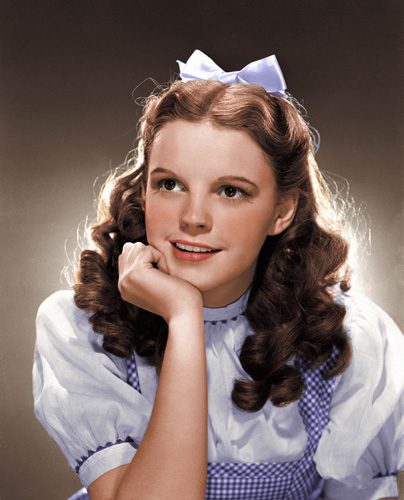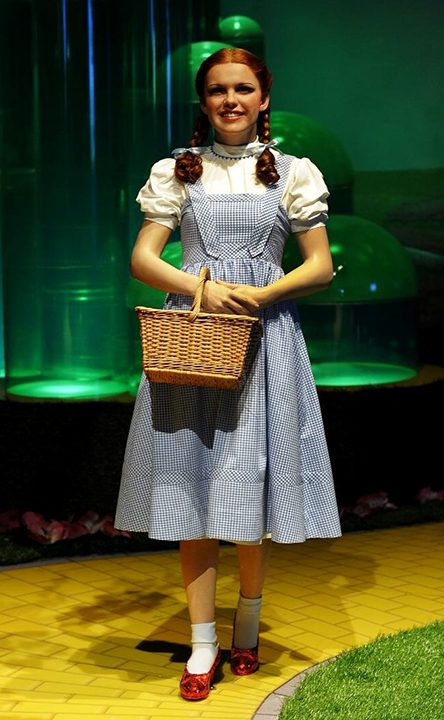
Judy Garland
Birthdate – June 10, 1922 (102 Years Old)
Birthplace – Grand Rapids, Minnesota, USA
One of the brightest, most tragic movie stars of Hollywood’s Golden Era, Judy Garland was a much-loved character whose warmth and spirit, along with her rich and exuberant voice, kept theatre-goers entertained with an array of delightful musicals.She was born Frances Ethel Gumm on 10 June 1922 in Minnesota, the youngest daughter of vaudevillians Ethel Marian (Milne) and Francis Avent “Frank” Gumm. She was of English, along with some Scottish and Irish, descent. Her mother, an ambitious woman gifted in playing various musical instruments, saw the potential in her daughter at the tender age of just 2 years old when Baby Frances repeatedly sang “Jingle Bells” until she was dragged from the stage kicking and screaming during one of their Christmas shows and immediately drafted her into a dance act, entitled “The Gumm Sisters,” along with her older sisters Mary Jane Gumm and Virginia Gumm. However, knowing that her youngest daughter would eventually become the biggest star, Ethel soon took Frances out of the act and together they traveled across America where she would perform in nightclubs, cabarets, hotels and theaters solo.Her family life was not a happy one, largely because of her mother’s drive for her to succeed as a performer and also her father’s closeted homosexuality. The Gumm family would regularly be forced to leave town owing to her father’s illicit affairs with other men, and from time to time they would be reduced to living out of their automobile. However, in September 1935 the Gumms’, in particular Ethel’s, prayers were answered when Frances was signed by Louis B. Mayer, mogul of leading film studio MGM, after hearing her sing. It was then that her name was changed from Frances Gumm to Judy Garland, after a popular ’30s song “Judy” and film critic Robert Garland.Tragedy soon followed, however, in the form of her father’s death of meningitis in November 1935. Having been given no assignments with the exception of singing on radio, Judy faced the threat of losing her job following the arrival of Deanna Durbin. Knowing that they couldn’t keep both of the teenage singers, MGM devised a short entitled Every Sunday (1936) which would be the girls’ screen test. However, despite being the outright winner and being kept on by MGM, Judy’s career did not officially kick off until she sang one of her most famous songs, “You Made Me Love You,” at Clark Gable’s birthday party in February 1937, during which Louis B. Mayer finally paid attention to the talented songstress.Prior to this her film debut in Pigskin Parade (1936), in which she played a teenage hillbilly, had left her career hanging in the balance. However, following her rendition of “You Made Me Love You,” MGM set to work preparing various musicals with which to keep Judy busy. All this had its toll on the young teenager, and she was given numerous pills by the studio doctors in order to combat her tiredness on set. Another problem was her weight fluctuation, but she was soon given amphetamines in order to give her the desired streamlined figure. This soon produced the downward spiral that resulted in her lifelong drug addiction.In 1939, Judy shot immediately to stardom with The Wizard of Oz (1939), in which she portrayed Dorothy, an orphaned girl living on a farm in the dry plains of Kansas who gets whisked off into the magical world of Oz on the other end of the rainbow. Her poignant performance and sweet delivery of her signature song, ‘Over The Rainbow,’ earned Judy a special juvenile Oscar statuette on 29 February 1940 for Best Performance by a Juvenile Actor. Now growing up, Judy began to yearn for meatier adult roles instead of the virginal characters she had been playing since she was 14. She was now taking an interest in men, and after starring in her final juvenile performance in Ziegfeld Girl (1941) alongside glamorous beauties Lana Turner and Hedy Lamarr, Judy got engaged to bandleader David Rose in May 1941, just two months after his divorce from Martha Raye. Despite planning a big wedding, the couple eloped to Las Vegas and married during the early hours of the morning on July 28, 1941 with just her mother Ethel and her stepfather Will Gilmore present. However, their marriage went downhill as, after discovering that she was pregnant in November 1942, David and MGM persuaded her to abort the baby in order to keep her good-girl image up. She did so and, as a result, was haunted for the rest of her life by her ‘inhumane actions.’ The couple separated in January 1943.By this time, Judy had starred in her first adult role as a vaudevillian during WWI in For Me and My Gal (1942). Within weeks of separation, Judy was soon having an affair with actor Tyrone Power, who was married to French actress Annabella. Their affair ended in May 1943, which was when her affair with producer Joseph L. Mankiewicz kicked off. He introduced her to psychoanalysis and she soon began to make decisions about her career on her own instead of being influenced by her domineering mother and MGM. Their affair ended in November 1943, and soon afterward Judy reluctantly began filming Meet Me in St. Louis (1944), which proved to be a big success. The director Vincente Minnelli highlighted Judy’s beauty for the first time on screen, having made the period musical in color, her first color film since The Wizard of Oz (1939). He showed off her large brandy-brown eyes and her full, thick lips and after filming ended in April 1944, a love affair resulted between director and actress and they were soon living together.Vincente began to mold Judy and her career, making her more beautiful and more popular with audiences worldwide. He directed her in The Clock (1945), and it was during the filming of this movie that the couple announced their engagement on set on January 9, 1945. Judy’s divorce from David Rose had been finalized on June 8, 1944 after almost three years of marriage, and despite her brief fling with Orson Welles, who at the time was married to screen sex goddess Rita Hayworth, on June 15, 1945 Judy made Vincente her second husband, tying the knot with him that afternoon at her mother’s home with her boss Louis B. Mayer giving her away and her best friend Betty Asher serving as bridesmaid. They spent three months on honeymoon in New York and afterwards Judy discovered that she was pregnant.On March 12, 1946 in Los Angeles, California, Judy gave birth to their daughter, Liza Minnelli, via cesarean section. It was a joyous time for the couple, but Judy was out of commission for weeks due to the cesarean and her postnatal depression, so she spent much of her time recuperating in bed. She soon returned to work, but married life was never the same for Vincente and Judy after they filmed The Pirate (1948) together in 1947. Judy’s mental health was fast deteriorating and she began hallucinating things and making false accusations toward people, especially her husband, making the filming a nightmare. She also began an affair with aspiring Russian actor Yul Brynner, but after the affair ended, Judy soon regained health and tried to salvage her failing marriage. She then teamed up with dancing legend Fred Astaire for the delightful musical Easter Parade (1948), which resulted in a successful comeback despite having Vincente fired from directing the musical. Afterwards, Judy’s health deteriorated and she began the first of several suicide attempts. In May 1949, she was checked into a rehabilitation center, which caused her much distress.She soon regained strength and was visited frequently by her lover Frank Sinatra, but never saw much of Vincente or Liza. On returning, Judy made In the Good Old Summertime (1949), which was also Liza’s film debut, albeit via an uncredited cameo. She had already been suspended by MGM for her lack of cooperation on the set of The Barkleys of Broadway (1949), which also resulted in her getting replaced by Ginger Rogers. After being replaced by Betty Hutton on Annie Get Your Gun (1950), Judy was suspended yet again before making her final film for MGM, entitled Summer Stock (1950). At 28, Judy received her third suspension and was fired by MGM, and her second marriage was soon dissolved.Having taken up with Sidney Luft, Judy traveled to London to star at the legendary Palladium. She was an instant success and after her divorce from Vincente Minnelli was finalized on March 29, 1951 after almost six years of marriage, Judy traveled with Sid to New York to make an appearance on Broadway. With her newfound fame on stage, Judy was stopped in her tracks in February 1952 when she became pregnant by her new lover, Sid. At the age of 30, she made him her third husband on June 8, 1952; the wedding was held at a friend’s ranch in Pasadena. Her relationship with her mother had long since been dissolved by this point, and after the birth of her second daughter, Lorna Luft, on November 21, 1952, she refused to allow her mother to see her granddaughter. Ethel then died in January 1953 of a heart attack, leaving Judy devastated and feeling guilty about not reconciling with her mother before her untimely demise.After the funeral, Judy signed a film contract with Warner Bros. to star in the musical remake of A Star Is Born (1937), which had starred Janet Gaynor, who had won the first-ever Academy Award for Best Actress in 1929. Filming soon began, resulting in an affair between Judy and her leading man, British star James Mason. She also picked up on her affair with Frank Sinatra, and after filming was complete Judy was yet again lauded as a great film star. She won a Golden Globe for her brilliant and truly outstanding performance as Esther Blodgett, nightclub singer turned movie star, but when it came to the Academy Awards, a distraught Judy lost out on the Best Actress Oscar to Grace Kelly for her portrayal of the wife of an alcoholic star in The Country Girl (1954). Many still argue that Judy should have won the Oscar over Grace Kelly. Continuing her work on stage, Judy gave birth to her beloved son, Joey Luft, on March 29, 1955. She soon began to lose her millions of dollars as a result of her husband’s strong gambling addiction, and with hundreds of debts to pay, Judy and Sid began a volatile, on-off relationship resulting in numerous divorce filings.In 1961, at the age of 39, Judy returned to her ailing film career, this time to star in Judgment at Nuremberg (1961), for which she received an Oscar nomination for Best Supporting Actress, but this time she lost out to Rita Moreno for her performance in West Side Story (1961). Her battles with alcoholism and drugs led to Judy’s making numerous headlines in newspapers, but she soldiered on, forming a close friendship with President John F. Kennedy. In 1963, Judy and Sid finally separated permanently, and on May 19, 1965 their divorce was finalized after almost 13 years of marriage. By this time, Judy, now 41, had made her final performance on film alongside Dirk Bogarde in I Could Go on Singing (1963). She married her fourth husband, Mark Herron, on November 14, 1965 in Las Vegas, but they separated in April 1966 after five months of marriage owing to his homosexuality. It was also that year that she began an affair with young journalist Tom Green. She then settled down in London after their affair ended, and she began dating disk jockey Mickey Deans in December 1968. They became engaged once her divorce from Mark Herron was finalized on January 9, 1969 after three years of marriage. She married Mickey, her fifth and final husband, in a register office in Chelsea, London, England on March 15, 1969.She continued working on stage, appearing several times with her daughter Liza. It was during a concert in Chelsea, London, England that Judy stumbled into her bathroom late one night and died of an overdose of barbiturates, the drug that had dominated her much of her life, on June 22, 1969 at the age of 47. Her daughter Liza Minnelli paid for her funeral, and her former lover James Mason delivered her touching eulogy. She is still an icon to this day with her famous performances in The Wizard of Oz (1939), Meet Me in St. Louis (1944), Easter Parade (1948), and A Star Is Born (1954).





















